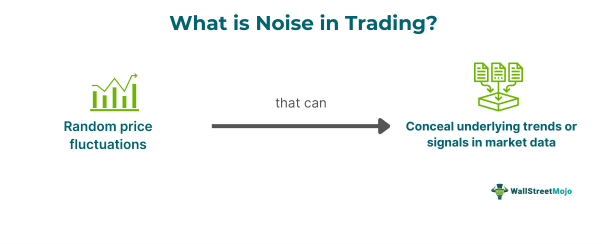Table of Contents
What Is Noise?
Noise in trading refers to the chaotic, ad hoc volatility in financial markets caused by noise traders, who do not base their decisions on technical or fundamental analysis. Noise affects pricing accuracy, undermines market stability, and makes investing methods more challenging.

It is used to create new trading strategies and market analyses related to patterns and trends in markets that escape traditional analysis. Traders and investors use it to manage trading risks by determining potential market dislocations while adjusting portfolios.
Key Takeaways
- Noise in trading describes spontaneous, erratic market volatility due to the actions of noise traders making decisions irrationally without technical analysis or professional help.
- It helps to know the impact of this phenomenon on financial strategy and different ways to lessen it.
- It is affected by speculation among traders, unskilled traders, emotional influences, impulsive decisions, lack of professional help, liquidity needs, and herd mentality.
- It can be avoided by using charts like Heikin-Ashi, Kagi, and Renko. Techniques such as ADX and DMI, higher time frames, combining multiple time frames, identifying long-term trends, and using moving averages also help mitigate this phenomenon.
Noise In Trading Explained
Noise refers to random or irrelevant market information and trading activity, enabling distortion of the actual picture of asset values and market trends. Trading noise happens because non-professional or inexperienced noise traders make decisions based on their fancies, emotions, short-term volatility, and other irrational parameters instead of technical or fundamental market analysis. They do not act as per professional advice or in-depth trading knowledge. Rather, their mental bias, media news, market sentiment, surrounding trading, or herd mentality motivate them.
Noise traders add to market volatility through their decisions, not depending on underlying asset value. Their impulsive trading may create artificial demand or deflation of share prices. They tend to oversell or overbuy stocks based on rumors or short-term factors. This tendency often arises from following herding behavior and trends and overreacting to good or bad news.
As a result, price volatility, mispricing, or disruption of financial market stability happen. This poses a risk to well-informed, knowledgeable, and disciplined traders who invest in short-term horizons that engage in arbitrage opposite to them. Therefore, it becomes crucial for expert traders to understand its impact and mitigate its effects on their investment strategies. This understanding enables them to make well-informed decisions and profit from market discrepancies and inefficiencies caused by noise traders.
Moreover, it can create sudden price bursts and bubbles, leading to economic downturns and financial crises. They may also make market oversights and financial regulations ineffective as their activities go undetected or unregulated.
Many traders use Saxo Bank International to research and invest in stocks across different markets. Its features like SAXO Stocks offer access to a wide range of global equities for investors.
Causes
Many factors contribute to this phenomenon in trading, as listed below:
- Inexperienced or unskilled traders, lacking knowledge or experience in the stock market, often engage in irrational trading.
- Traders influenced by emotions like panic, greed, or fear make wrong and impulsive trading decisions.
- Traders do not take professional help or technical analysis, often relying on hype, rumors, or unwarranted information to base their trading.
- Traders with a herd mentality often follow others in executing their share trades without conducting any analysis, contributing to trading cascades that amplify this occurence.
- Many times, traders have to sell assets out of the need for liquidity in their personal needs, leading to noise.
- Some traders also join the market for speculation or time-varying liquidity needs.
How To Trade Without Market Noise?
One must consider the following strategies to trade without creating this phenomenon:
- Use of higher time frames such as monthly, weekly, or daily must be used to smoothen out short-term volatility and present a larger market picture.
- Identify long-term trends or short-term noise by combining numerous time frames.
- Any potential exit or entry points plus strength and direction of trend could be identified by moving averages.
- Combine many moving averages with various periods to filter noise by creating crossover signals.
- Channels and trendlines point out the time at which price may break or bounce and the point at which to put stop-loss and take-profit orders.
- Use moving averages to spot the direction of the trend and the average price of an asset.
- Put to use the multi-frame analysis in the identification of patterns and trends not recognizable in a single time frame.
- One can also use different chart types like Heikin-Ashi and Kagi charts, along with Renko and techniques available, like the Average Directional Index ( ADX) & Directional Movement Index (DMI), to have a clear picture of the market trends.
Examples
Let us use a few examples to understand the topic.
Example #1
Let us assume Joe is an impulsive trader on the Old York Stock Exchange. He holds shares of York medicines at $100 each in 100 quantities. He learns from his WhatsApp group that York Medicine has gone bankrupt. As a result, he becomes emotionally charged and starts panicking without verifying the bankruptcy news. Therefore, he begins selling all his valuable shares at $80, fearing investment loss.
His impulsive selling led to a rapid plunge in York medicines prices because other traders accompanied his selling. Thus, the share prices kept on dropping, leading to a loss to Joe and other traders despite the fact that the bankruptcy news was a well-calculated ploy by its rivals to buy the majority share in the company.
Example #2
An article published on October 9, 2018,discusses the significant impact of noise traders on the market, posing challenges to the efficient market hypothesis (EMH). It also highlights that self-directed investors have grown notably to 4 million self-taught traders in America, which form 25% of US adults approximately having internet access.
On the other hand, there are only 2.8 million professional and knowledgeable traders. Further, 61 % of quasi-indexers or institutional investors suggest that such a phenomenon occurs even among professionals. Moreover, Tilray (TLRY) magnifies such trading, rising to 1500% post-IPO, driven by frenzied speculation instead of rational valuation.
Disclosure: This article contains affiliate links. If you sign up through these links, we may earn a small commission at no extra cost to you.

